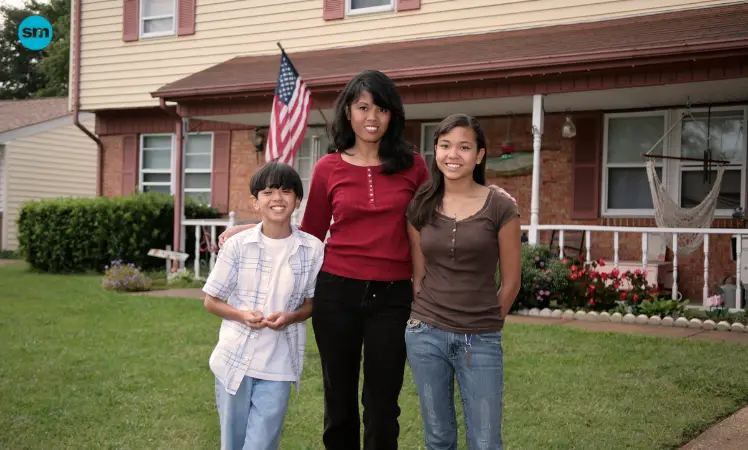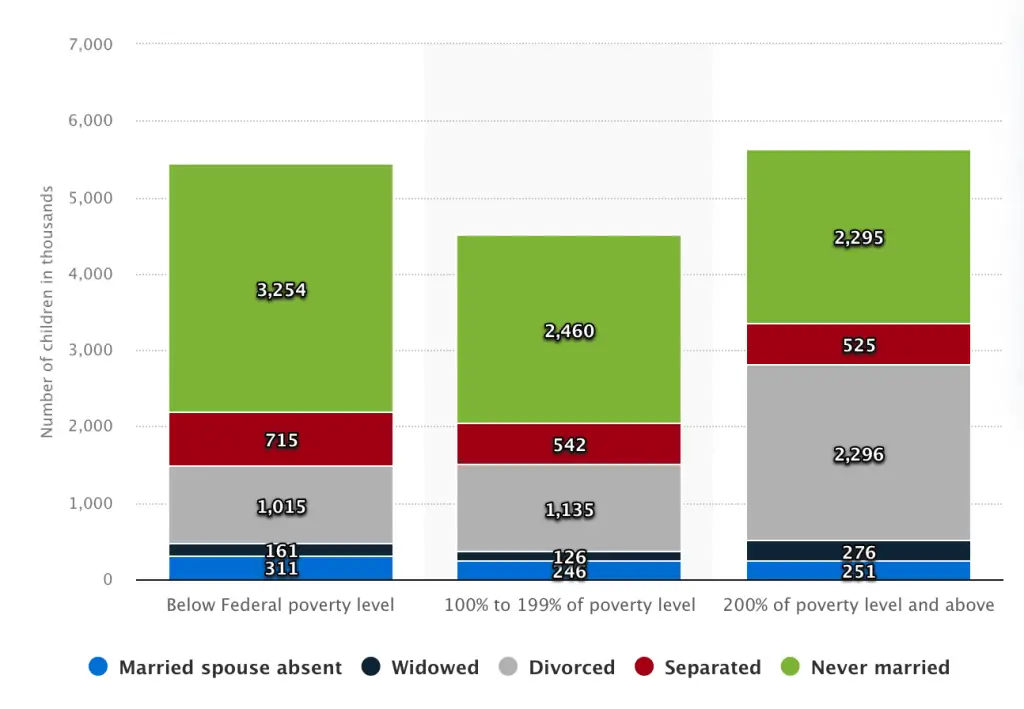Last Updated on January 24, 2024 by Lori Pace
The statistics of life are changing right before our eyes. We discuss the changing statistics of the single mother in the US with this in-depth article.
Everything is changing. More people are working thanks to COVID-19. We can easily catch up with relatives on the other side of the world with a simple video call.
Even families have changed.
Children living in a single-parent home have become more common in the US. People always considered a two-parent home with a mom, dad, and maybe three kids as a typical household.
But that was WAY back then! You know that dark time when we had black and white TVs and having dinner for the hubby after a long day at work.
Today, ALL that has changed.
Being a single mother is no longer uncommon – we share the statistics.
According to the Census Bureau, in 2021, there are about 11 million single parent families with children under the age of 18. 80% of which were headed by single mothers.
23.4% of which were poor and 27.7% were food insecure.
Despite the changing dynamic of families, single moms in the US still battle stereotypes from their communities.
Common myths and statistics of single mothers
Many Americans still believe that single moms are:
- A terrible thing for society.
- Unemployed and are uneducated.
- Impoverished because they are lazy and don’t want to work.
- Making bad decisions because they haven’t been married and have children.
For a long time, women had always been judged and even punished for being sexually active outside marriage. The reality is that single moms often do not have the TIME to go out and party as many people would believe.
Many single moms often have to work multiple jobs WHILE managing their homes and making sure their children are cared for.
In some cases, single moms have gone through a painful divorce. In other cases, the fathers of their children might have just left and no longer help take care of their children.
These situations often lead to single moms being more likely to be selective about dates and bringing home to meet their children.
The reality is that just because many single moms live an impoverished lifestyle doesn’t mean they are unemployed.
More than half of the single moms in the US have earned a Bachelor’s Degree. Even single moms have managed to become entrepreneurs, leaders, and CEOs.
Because many single moms live either on or below the poverty line, some believe that single moms drain government resources.
Many people condemn single moms for relying on government schemes such as Medicaid, cash, and food assistance to help them take care of themselves. It’s easy for them to forget that single moms don’t receive child support from their children’s fathers.
This means that they have to find other ways to make sure their children have all the necessities they need for school and at home.
These stereotypes hurt not only single moms but ALSO their children.
So, what is a single mom in 2024?
A single mom is a woman who has a child or children she raises in her own home.
She can be a grandmother raising her grandchildren or grandchild, she can be divorced, widowed, left before marriage, or not even know who the father is.
There are many reasons for women to become single mothers, but what do they all have in common?
They don’t have the support of a loving spouse or partner.
They wake up every day, and they work their BUTTS off to be the best moms they can be for their children.
- 52.3% of single moms have never been married
- 29.3% had a divorce
- 18.4% were either widowed or separated
About one-third of these women were black, while two-thirds were white.
Statistics Of Single Mother Unemployment Rates
Even though single motherhood has become more common nowadays, it doesn’t mean that it has become easier to be a single mom. As mentioned before, more than 80% of single-parent homes in the US belong to single moms.
About 34% of single moms were poor. And just over 29% had been unemployed for a WHOLE year!
What does that mean?
Well, it means that many single moms across the US couldn’t find work. And having no job means a dwindling cash flow that’s needed to feed and clothe their children. This also meant that some single mothers weren’t sure where their next meal would come from.
Single Mother Financial Statistics
The single moms who could hang onto their jobs still lag behind single dads or other employed men.
According to the National Women’s Law Center, women’s earning power is still comparable to men’s by about 82¢ to $1 for the SAME job.
That’s a WHOLE gap of 18¢ on the dollar!
It’s even WORSE for women of color.
African-American women only earn 64¢ while Hispanic and Latinas are just paid 56¢ on the dollar.
This is why most single mothers are financially worse off than their married counterparts.
In 2020, Census Bureau discovered that the average income for single mothers in the US was ONLY $49 214.
This is just below HALF the average income of married couples, which is $101 517.
This is even scarier when you discover ONLY a third of single moms get ANY child support from the fathers. Additionally, they only receive an average of $286 a month from fathers who give child support.
The Statistics Of Poverty Rate Of Single Moms In The US
Single moms are almost FIVE times more likely to be poorer than married moms with children in the US.
- 38.1% of children who live in a single mom household live in impoverished conditions.
- In comparison, ONLY 7.5% of children who lived with married parents were considered low-income.
- Two out of five (35%) Black single moms live in poverty.
- While another 34% consisted of Hispanic single moms, and 22% were of Asian descent.
- Native American single moms have the highest poverty rate of 43%.
- This is a high poverty rate compared to the 26% poverty rate for White single moms in the US.
Challenges for single moms in the US
Nearly a third (27.7%) of single moms were considered “food insecure in the US.”
To put this in human terms, it means that a third of single moms weren’t sure where the next meal for them and their children would come from. There was a good chance that their children went to bed with their empty stomachs grumbling.
And just about one-ninth (11.7%) used food pantries.
Single moms in the US also have to spend AT LEAST one-third of their salary on housing. This problem is probably the most significant financial burden for single moms.
This means that because single moms live in poverty, they are MORE vulnerable to becoming homeless.
A single mom headed 60% of homeless families, and HALF of these families were African American single moms (49%). All this made up 21% of the homeless population in the US.
Single Mother Statistics On Welfare And Food Stamps
Across the US, single moms made up more than half (62%) of SNAP households with children.
BUT only 11% received any CASH benefits from TANF.
With children, only 38% received food stamps. The other two-thirds of children received free or cheaper meals.
Even though this does help feed children of single moms, it’s still not enough to meet the bare minimum needed to avoid living on the street and going hungry.
This might seem bleak, but there is some good.
- TANF provides benefits for families that have three members.
- And in 33 states, there were 30% fewer families on the poverty line. In the District of Columbia, 50% of families live on the poverty line.
Access To Healthcare For Single Moms
Getting access to health care is one of the biggest concerns for single moms all over the US.
There is a BIG chance for ANY single mom that you won’t have access to adequate health insurance.
More than 13.4% of single moms don’t have health insurance, while ONLY 6.7% of married couples didn’t have health care covered.
There has been some progress in giving low-income single moms access to adequate health insurance, thanks to the Affordable Care Act.
BUT there are still 16 states that have REFUSED to expand their Medicaid programs.
For these states, the average number of single moms considered eligible for Medicaid coverage is 31.2%.
Out of these states, Tennessee and Wisconsin are the ONLY two states that cover single moms that are dangerously close or are ALREADY living in poverty.
Single Mother Child Care And Education Statistics
In the US, the cost of taking care of a baby is 40% MORE than the AVERAGE income of a single mom.
For a child in school, the cost is 32% more than the average income of a single mom.
In states such as Oregon, California, and Massachusetts, single mothers who have children under three will have to use MORE than half of their salary for daycare.
If by some SLIM chance, a single mom might be eligible for a child care subsidy.
As of 2019, 15 states either had frozen their child care assistance benefits or had waitlists for single moms waiting to see if they were eligible.
The longest wait time being two YEARS.
There isn’t any money left to pay for their tuition fees and other expenses for single moms trying to further their education.
On top of the child care expenses, that takes a THIRD of a single mom’s salary. And OVER half of a single mom’s salary is used to take care of housing expenses.
Only one-third of single moms have managed to graduate with a college degree. BUT one-sixth of single moms couldn’t even complete high school.
Single Moms In Other Countries
Compared to other countries, single mothers in the US have to work MORE hours but still have HIGHER poverty rates. This is because 40% of single parents in the US work low-wage jobs. Also, in most cases, single moms don’t have access to paid leave.
In Denmark, workers get 18 weeks of paid leave, and in Sweden, workers get 480 days of paid leave. Also, in the US, the government safety net programs are not as generous as those you find in European countries. In European countries, creating economic independence, especially for single mothers, has become a top priority.
The national governments in the European Union (EU) are responsible for providing social security and benefits for single moms. So the benefits will be different from country to country.
The EU has worked to help single moms have a better work-life balance by making sure that parental leave is easier to access. Such as FOUR months of paid sick leave.
For single moms with children under 8, single moms can have flexible work arrangements to take care of their children in an emergency.
Good quality education and care for young children have also become a priority in the EU. There are currently plans to improve access to educational facilities, especially for children who live in poverty. Part of the plan is to provide funds to improve child care centers and education for children of single parents.
Final Word About Single Mother Statistics In 2024
We hope this article gave you all the single mother statistics of 2022 you required. If you’re a single mother in need of assistance, have a look at our grants for single moms page.




